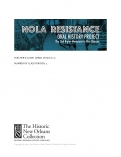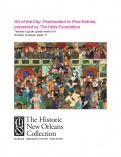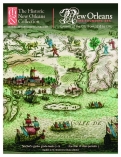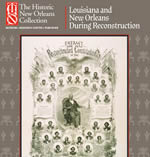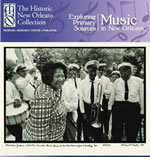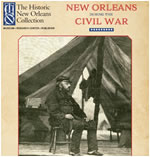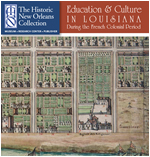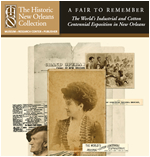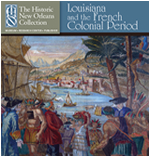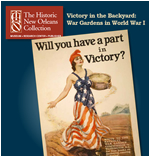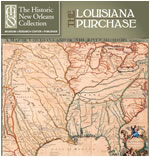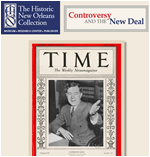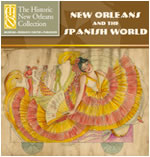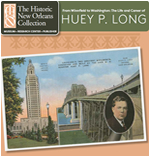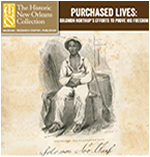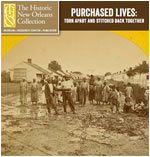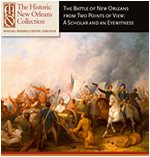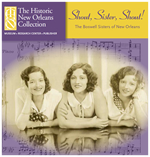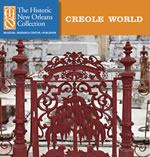Lesson Plans
This curriculum, based on oral histories collected as part of the NOLA Resistance project, prompts students to engage with primary and secondary historical sources to examine the experiences of local civil rights leaders. The three lessons—Stories of Resistance, Young Leaders of New Orleans, and Integrating McDonogh 19—help students cultivate critical thinking skills, further develop their reading comprehension abilities, and gain experience in assessing different types of historical sources.
The five lessons included in this unit are connected to the exhibition Art of the City: Postmodern to Post-Katrina, presented by the Helis Foundation. Through this curriculum, educators can engage students with artistic methods, environmental issues, and the complex dynamics of the city. Lessons include using Visual Thinking Strategies to analyze artwork, the intersection of art and environment, the art of portraiture, connecting abstract art and music, and how street art transforms communities.
This unit includes three lessons that engage students in analysis of earliest days of the city under French control. In the first lesson, Africans and African Americans in Early New Orleans, students will analyze two documents that look at the roles of Africans and African Americans in early colonial New Orleans in order to understand the population's significance. The second lesson, Examining Colonial-Era Census Records, has students examine statistics from census records collected in and around New Orleans in the early to mid-eighteenth century, then respond to questions about the documentation of early inhabitants of the colony. The third section, Mapping Early Colonial New Orleans, focuses on maps that span the French colonial period so students can analyze how city planners documented the growth and changes that the city experienced during this time.
In this instructional unit, students will analyze and compare documents and images from the Reconstruction era. The experiences and viewpoints of African American and white residents of Louisiana and New Orleans will allow students to evaluate the implementation and impact of federal legislation and constitutional amendments. By answering essential questions and assessing a variety of primary sources, the students will evaluate historical evidence, draw conclusions, and develop viewpoints for discussion and presentation.
In this lesson, students will learn how to find, identify, and evaluate primary and secondary historical sources. Using items from The Historic New Orleans Collection that highlight the rich history of music in New Orleans, students will practice primary source analysis.
Over the course of five lessons, students will learn about the experiences of Union and Confederate supporters in New Orleans amid the movement for secession and the occupation of the city. Students will analyze a variety of primary sources—including excerpts from speeches, sermons, military orders, letters, memoranda, newspaper articles, proclamations, and other firsthand accounts—to draw conclusions and develop viewpoints for discussion with the class.
Over the course of three lessons, students will analyze primary- and secondary-source documents as they examine the educational and cultural life in Louisiana during the French colonial period. Students will closely analyze images, letters, and other primary-source documents, along with secondary sources with the purpose of not only understanding the literal but also inferring the more subtle messages of the period. Students’ understanding and accountability will be determined using class discussion, graphic organizers, and critical-thinking questions.
These lesson plans stem from Musical Louisiana: America’s Cultural Heritage, an annual series presented by The Historic New Orleans Collection and the Louisiana Philharmonic Orchestra. This year’s theme highlights the extraordinary 1884–1885 concert season, during which New Orleans hosted the World's Industrial and Cotton Centennial Exposition. The city's already rich tradition of music proved to be a fertile setting for the fair, resulting in an unparalleled musical season. Each set of lesson plans focuses on a particular aspect of this event: lessons 1–4 explore the historical and cultural impacts of the exposition on the city, and lessons 5–7 focus on how tradition, technology, and culture acted as hallmarks of the 1884–1885 concert season in New Orleans. Lessons 1–4 are by Alfred E. Lemmon, director of the Williams Research Center, and by Eric Seiferth, assistant curator/historian. Lessons 5–7 are by Amanda Wuerstlin, director of education and community engagement, Louisiana Philharmonic Orchestra.
Over the course of four lessons, students will analyze both secondary- and primary-source documents. Students will study the geography, economics, and key figures and events of the French colonial period. Students will closely analyze these primary and secondary sources with the purpose of not only understanding the literal but also inferring the more subtle messages. Students' understanding will be determined using graphic organizers, class discussion, and critical-thinking questions.
In this lesson, students will examine images dealing with war gardens in the US during World War I in order to understand some of the ways the media was used to influence civilians during the war. Additionally, students will use basic math skills to analyze aspects of planning, planting, and harvesting the bounty of war gardens.
Over the course of three lessons, the students will explore events that led to the United States’ purchase of the Louisiana Purchase territory from France in 1803. Students will analyze key letters from US officials regarding the negotiations for the purchase of New Orleans that ultimately resulted in a much larger purchase, doubling the land in the United States. Students also will examine and evaluate maps of the area to understand the impact of the Purchase.
Over the course of three to four lessons, the students will analyze five primary source documents. These texts are excerpted from five statements expressing different points of view on President Franklin D. Roosevelt's New Deal. Students will closely analyze these primary sources with the purpose of not only understanding the literal meaning of the texts but also inferring the more subtle messages. In addition the students will read a number of secondary sources designed to provide background information on the period. Students' understanding of the texts will be determined through answers to critical analysis questions and a dramatic culminating activity.
These lesson plans stem from Musical Louisiana: America's Cultural Heritage, an annual series presented by The Historic New Orleans Collection and the Louisiana Philharmonic Orchestra. This year's theme celebrates the rich cultural and musical relations between Spain and Louisiana. Each set of lesson plans focuses on a particular aspect of this relationship: lessons 1–3, from The Historic New Orleans Collection, explore the historical connections between Spain and New Orleans from the colonial period up to the late nineteenth century, and lessons 4–6, from the Louisiana Philharmonic Orchestra, involve listening activities with musical selections and reading materials about the composers.
Over the course of four lessons, students will analyze both primary and secondary source documents to gain an understanding of Huey Long’s life and the deep—and, at times, conflicting—influence he had on the government and politics of Louisiana and America. Students will read and analyze a rich narrative by scholars and various primary source documents. This lesson plan is offered in conjunction with the exhibition From Winnfield to Washington: The Life and Career of Huey P. Long.
Over the course of five lessons, students will analyze both primary and secondary source documents to gain an appreciation and understanding of Solomon Northup's kidnapping and his relentless efforts to regain his freedom. Northup's autobiography, Twelve Years a Slave, is one of the more acclaimed slave narratives in American history. These lessons complement the exhibition Purchased Lives: New Orleans and the Domestic Slave Trade, 1808–1865, which was on view at THNOC in 2015.
Over the course of four lessons, students will analyze both primary and secondary sources to study various aspects of the slave trade in the United States, specifically as related to the buying and selling of human beings in and around New Orleans. These lessons complement the exhibition Purchased Lives: New Orleans and the Domestic Slave Trade, 1808–1865, which was on view at THNOC in 2015.
Over the course of four lessons, students will analyze both primary and secondary source documents to gain an appreciation for the causes, consequences, and key figures of the Battle of New Orleans. These source materials will prompt students to look at the event from different perspectives. An 1815 letter written by a young woman residing in the city will provide students with a sense of immediacy—while a present-day narrative overview will provide the advantage of hindsight.
Over the course of four lessons, students will explore the life and music of the Boswell Sisters and the lasting contributions these pioneers made to American musical culture. Raised in New Orleans, where they received formal lessons in classical music while absorbing the sounds of the city's jazz scene, the Boswell Sisters were among the first stars of radio's golden age, selling out shows nationally and internationally and recording with the biggest names of the 1920s and '30s. Their innovative approach to jazz vocal harmony influenced musicians for decades, from direct successors such as the Andrews Sisters and Ella Fitzgerald to country-music queens the Judds.
Over the course of five lessons, students will analyze elements of the book Creole World: Photographs of New Orleans and the Latin Caribbean Sphere by Richard Sexton, with essays by Jay D. Edwards and John H. Lawrence. The Edwards essay, which serves as an introduction to the Sexton book, provides a historical framework for understanding the term "Creole." After reading excerpts from the Edwards essay, and additional commentary from Lawrence and Sexton, students will analyze a selection of Sexton’s photographs from New Orleans and various locations in the Caribbean, Central America, and South America—and will investigate the shared aspects of Creole culture and heritage that can be seen in these images. Students will closely analyze these sources and use both textual and visual evidence to draw conclusions and present their findings, as directed in each lesson.

